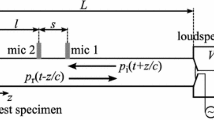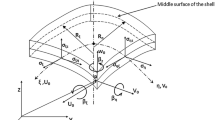Abstract
The acoustic behaviour of a tube is well known since antiquity, nevertheless, differences appear when a flexible element interferes this behaviour. The tube acoustic resonance is altered by the mechanic resonance of this element due to complex mechano-acoustic effects. In this paper, an experiment is designed to evaluate the response of a tube with a membrane at the end, subject to sound pressure at the open side of the tube. A baffle isolates both sides of the tube. A comprehensive numerical study is made to understand the behaviour of different parameter of the system as the tube length and those related with the membrane stiffness and mass. A proper numerical methodology has been developed and is described and justified. The study of the simple tube system is also accomplished finding that results match with the theoretical expected values with an effective length correction. Regarding the behaviour of the tube-membrane system, it is found that the membrane is not a transparent element, but its contribution as closing element is limited to a 10 dB sound pressure drop compared with the absence of membrane. The acoustic resonance of the tube is affected by the membrane resonance but a general pattern similar to the open-closed case is observed. No presence of the open-open case is found.













Similar content being viewed by others
References
Rayleigh L (1894) The theory of sound. Macmillan, London
Von Helmholtz H, Ellis AJ (1895) On the sensations of tone as a physiological basis for the theory of music. London, Longmans, Green, and Co., New York
Fletcher NH, Rossing TD (1998) The physics of musical instrument, 2nd edn. Springer-Verlag, New York
Von Bekesy G (1960) Experiment in hearing. McGraw-Hill, New York
Kirikae I (1960) The structure and function of Middle Ear. Tokio University Press, Tokio
Gelfand SA (2009) Essentials of audiology, 3rd edn. Thieme, Stuttgart
Stinson M, Lawton B (1989) Specification of the geometry of the human ear canal for the pre-diction of sound-pressure level distribution. J Acoust Soc Am 85:2492–2503
Stinson M, Khanna SM (1989) Sound propagation in the ear canal and coupling to the ear-drum, with measurements on model systems. J Acoust Soc Am 85:2481–2491
Hammershoi D, Moller H (1996) Sound transmission to and within the human ear canal. J Acoust Soc Am 100:408–427
Caminos L, Garcia‐Gonzalez A, Gonzalez‐Herrera A (2011) Numerical analysis of the influence of the auditory external canal geometry on the human hearing response. In: Progress in Auditory Biomechanics, AIP Conference Proceedings, vol 1403, no 1, pp 515–520
Gan R, Reeves B, Wang X (2007) Modeling of sound transmission from ear canal to cochlea. Ann Biomed Eng 35:2180–2195
Gan R, Sun Q, Feng B, Wood MW (2006) Acoustic–structural coupled finite element analysis for sound transmission in human ear-Pressure distributions. Med Eng Phys 28:395–404
Garcia-Gonzalez A, Castro-Egler C, Gonzalez-Herrera A (2016) Analysis of the mechano-acoustic influence of the tympanic cavity in the auditory system. BioMed Eng OnLine 15:33
Rabbitt RD (1990) A hierarchy of examples illustrating the acoustic coupling of the eardrum. J Acoust Soc Am 87:2566–2582
Gonzalez-Herrera A, Olson ES (2015) A study of sound transmission in an abstract middle ear using physical and finite element models. J Acoust Soc Am 138:2972–2985
Bergevin C, Olson ES (2014) External and middle ear sound pressure distribution and acoustic coupling to the tympanic membrane. J Acoust Soc Am 135:1294–1312
Gonzalez-Herrera A, Cheng JT, Rosowski JJ (2015) Analysis of the influence of the speaker position on the study of the dynamic behavior of a membrane combining holography technique and finite element models. In: 22nd International Congress on Sound and Vibration (IIAV). Florence, Italy
De Greef D, Buytaert JAN, Aerts JRM, Van Hoorebeke L, Dierick M, Dirckx J (2015) Details of human middle ear morphology based on micro-CT imaging of phosphotungstic acid stained samples. J Morphol 276:1025–1046
Timoshenko S (1937) Vibration problems in engineering. D. Van Nostrand Company, inc., New York
Acknowledgements
This research did not receive any specific grant from funding agencies in the public, commercial, or not-for-profit sectors.
Author information
Authors and Affiliations
Corresponding author
Ethics declarations
Conflict of interest
The authors declare that they have no conflict of interest.
Rights and permissions
About this article
Cite this article
Gonzalez-Herrera, A., Garcia-Manrique, J. Numerical study of the mechano-acoustic coupled resonance of a tube-membrane system. Meccanica 53, 3189–3207 (2018). https://doi.org/10.1007/s11012-018-0882-7
Received:
Accepted:
Published:
Issue Date:
DOI: https://doi.org/10.1007/s11012-018-0882-7




